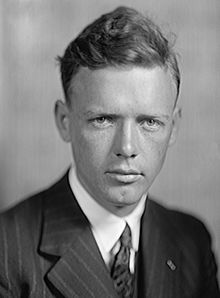
Back Charles Lindbergh Afrikaans تشارلز لندبرغ Arabic تشارلز لندبرج ARZ Çarlz Lindberq Azerbaijani چارلز لیندبرق AZB Charles Lindbergh BCL Чарлз Ліндберг Byelorussian Чарлз Линдберг Bulgarian চার্লস লিন্ডবার্গ Bengali/Bangla Charles Lindbergh Breton
Charles Lindbergh | |
|---|---|
 Photo by Harris & Ewing, c. 1927 | |
| Born | February 4, 1902 Detroit, Michigan, U.S. |
| Died | August 26, 1974 (aged 72) Kipahulu, Hawaii, U.S. |
| Resting place | Palapala Ho'omau Church, Kipahulu |
| Other names |
|
| Education | University of Wisconsin–Madison (no degree) |
| Occupations |
|
| Known for | First solo transatlantic flight (1927), pioneer of international commercial aviation and air mail |
| Spouse | |
| Children | 13,[N 1] including Charles Jr., Jon, Anne, and Reeve |
| Parents |
|
| Military career | |
| Service | |
| Years of service | 1924–1941, 1954–1974 |
| Rank |
|
| Battles / wars | World War II |
| Awards | |
| Signature | |
 | |
Charles Augustus Lindbergh (February 4, 1902 – August 26, 1974) was an American aviator, author, and military officer. On May 20–21, 1927, he made the first nonstop flight from New York City to Paris, a distance of 3,600 miles (5,800 km), flying alone for 33.5 hours in the first solo transatlantic flight. His aircraft, the Spirit of St. Louis, was designed to compete for the $25,000 Orteig Prize for the first flight between the two cities.
Lindbergh was raised mostly in Little Falls, Minnesota, and Washington, D.C., the son of U.S. Congressman Charles August Lindbergh. He became a U.S. Army Air Service cadet in 1924. Later that year, he was hired as a U.S. Air Mail pilot in the Greater St. Louis area, where he began to prepare for his historic 1927 transatlantic flight. For his flight, President Calvin Coolidge presented Lindbergh both the Distinguished Flying Cross and Medal of Honor, the highest U.S. military award.[4] He also earned the highest French order of merit, the Legion of Honor.[5] His achievement spurred significant global interest in both commercial aviation and air mail, which revolutionized the aviation industry worldwide (a phenomenon dubbed the "Lindbergh boom"), and he spent much time promoting these industries.
Time magazine honored Lindbergh as its first Man of the Year in 1928, President Herbert Hoover appointed him to the National Advisory Committee for Aeronautics in 1929, and he received the Congressional Gold Medal in 1930. In 1931, he and French surgeon Alexis Carrel began work on inventing the first perfusion pump, a device credited with making future heart surgeries and organ transplantation possible.
On March 1, 1932, Lindbergh's first-born infant child, Charles Jr., was kidnapped and murdered in what the American media called the "crime of the century". The case prompted the U.S. to establish kidnapping as a federal crime if a kidnapper crosses state lines with a victim. By late 1935, the press and hysteria surrounding the case had driven the Lindbergh family into exile in Europe, from where they returned in 1939. In the months before the United States entered World War II, Lindbergh's non-interventionist stance and statements about Jews and race led some to believe he was a Nazi sympathizer, although Lindbergh never publicly stated support for the Nazis and condemned them several times in both his public speeches and personal diary. However, he supported the isolationist America First Committee and resigned from the U.S. Army Air Corps in April 1941 after President Franklin Roosevelt publicly rebuked him for his views.[6] In September 1941, Lindbergh gave a significant address, titled "Speech on Neutrality", outlining his position and arguments against greater American involvement in the war.[7]
Following the Japanese attack on Pearl Harbor and German declaration of war against the U.S., Lindbergh avidly supported the American war effort but was rejected for active duty, as Roosevelt refused to restore his commission.[8] Instead he flew 50 combat missions in the Pacific Theater as a civilian consultant and was unofficially credited with shooting down an enemy aircraft.[9][10] In 1954, President Dwight Eisenhower restored his commission and promoted him to brigadier general in the U.S. Air Force Reserve.[11] In his later years, he became a Pulitzer Prize-winning author, international explorer and environmentalist, helping to establish national parks in the U.S. and protect certain endangered species and tribal people in both the Philippines and east Africa.[12] After retiring in Maui, Lindbergh died in 1974.
- ^ Every and Tracy 1927, pp. 60, 84, 99, 208.
- ^ Cite error: The named reference
Schröckwas invoked but never defined (see the help page). - ^ "Charles Augustus Lindbergh Jr. | Interim 1920 - 1940 | U.S. Army Air Corps Reserve | Medal of Honor Recipient". Congressional Medal of Honor Society. Archived from the original on October 7, 2021. Retrieved October 7, 2021.
Highest Rank: Brigadier General
- ^ Bryson 2013, pp. 25–104.
- ^ Cite error: The named reference
CriticalPast-1927was invoked but never defined (see the help page). - ^ Cite error: The named reference
NYT-1941was invoked but never defined (see the help page). - ^ "Charles Lindbergh's Sept 1 1941 Speech". www.historyonthenet.com. Archived from the original on June 21, 2019. Retrieved September 12, 2019.
- ^ Berg 1998, pp. 431–437.
- ^ "Colonel Lindbergh On Combat Missions". The San Bernardino Daily Sun. Vol. 51. Associated Press. October 23, 1944. p. 1.
- ^ Cite error: The named reference
475thFighterGroupwas invoked but never defined (see the help page). - ^ "Lindbergh Is Named A Brigadier General; Lindbergh Named Reserve General". The New York Times. February 16, 1954. ISSN 0362-4331. Retrieved October 7, 2021.
- ^ "Environmentalist". Minnesota Historical Society - Charles Lindbergh House and Museum. Retrieved November 7, 2022.
Cite error: There are <ref group=N> tags on this page, but the references will not show without a {{reflist|group=N}} template (see the help page).